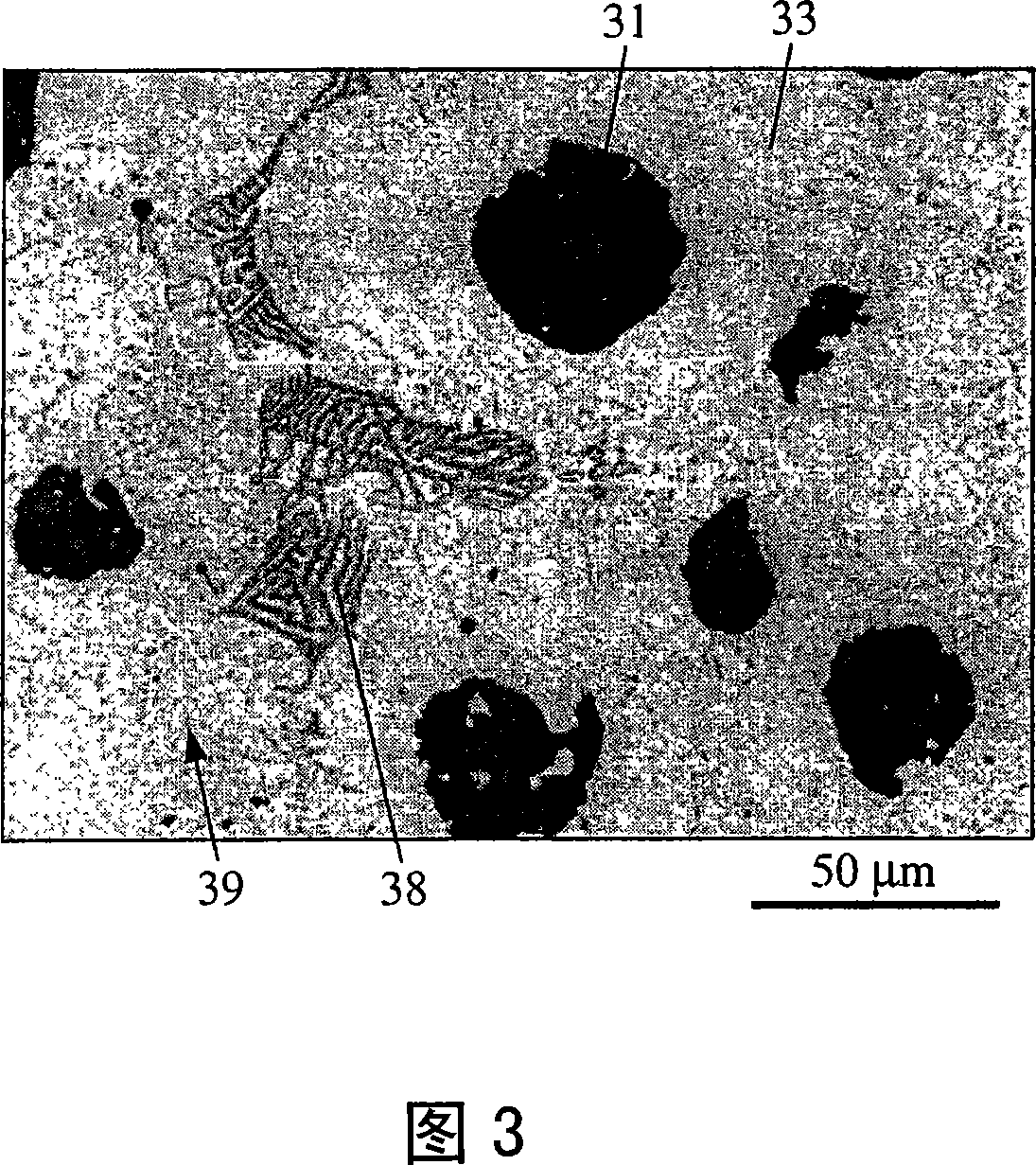Heat resisting cast iron and exhaust system part therefrom
一种耐热铸铁、排气系统的技术,应用在排气装置、发动机元件、机械设备等方向,能够解决常温拉伸降低、韧性及延展性降低、无法确保耐久性等问题,达到性能提高、耐氧化性及耐热裂纹性优异的效果
- Summary
- Abstract
- Description
- Claims
- Application Information
AI Technical Summary
Problems solved by technology
Method used
Image
Examples
Embodiment 1~74
[0135] Embodiments 1-74, comparative examples 1-16, existing examples 1-6
[0136] with SiO 2Cast iron having the chemical composition (weight%) shown in Table 1 was melted in the atmosphere of a 100kg high-frequency furnace for lining, and the iron was tapped at 1450°C or higher, and the process was carried out according to the sandwich method using commercially available Fe-Si-Mg. Spheroidization. Immediately thereafter, it is cast into the Y mold at 1300°C or higher. After demoulding, each sample was subjected to shot blasting, and as shown in Table 2, after being kept at a temperature of 600 to 940° C. for 3 hours, furnace-cooled ferritizing annealing was performed. In addition, the test materials of Example 9, Comparative Examples 1 and 9, and Conventional Examples 1, 2 and 4 were not heat-treated, and the test materials of Comparative Example 2 were subjected to ferrite cooling by air cooling instead of furnace cooling. annealing. The samples of Conventional Examples...
Embodiment 75
[0231] Using the heat-resistant cast iron of Example 9, the exhaust manifold 151 shown schematically in FIG. 17 was cast, and then machined directly in the cast state. The obtained exhaust manifold 151 had no casting defects such as pores, stagnation, and gas defects, and no problems such as cutting inconvenience occurred during machining. Also in Fig. 17, 151a denotes a mounting flange, 151b denotes a branch pipe, and 151c denotes a gathering portion.
[0232] The exhaust manifold 151 of Example 75 was assembled on an exhaust simulator (simulator) simulating a high-performance gasoline engine (gasoline engine) with a displacement of 2000 cc with inline 4 cylinders, and the durability test was carried out to investigate the life and cracks until cracks occurred. Occurs. As test conditions, a heating-cooling cycle consisting of heating for 10 minutes and cooling for 10 minutes was repeated, and the number of cycles until cracks penetrating the exhaust manifold 151 occurred was...
Embodiment 76
[0235] Exhaust manifold 151 was manufactured from the heat-resistant cast iron of Example 8 in the same manner as in Example 75 except that it was held at 900° C. for 3 hours and then subjected to furnace-cooled ferritization annealing. The obtained exhaust manifold 151 had no casting defects, and no problems such as deformation due to heat treatment and problems in machining. The exhaust manifold 151 of Example 76 was assembled in an exhaust simulator, and an endurance test was carried out under the same conditions as in Example 75. The surface temperature of the exhaust manifold 151 is the same as that of Example 75. As a result of the durability test, in the exhaust manifold 151 of Example 76, minute cracks of the same degree occurred at the same position as that of Example 75 after 952 cycles. However, no cracks occurred in the collection part where the high-temperature exhaust gas passes, and the entire part was hardly oxidized, and it was confirmed that it has excellent...
PUM
| Property | Measurement | Unit |
|---|---|---|
| phase transition temperature | aaaaa | aaaaa |
| stretch ratio | aaaaa | aaaaa |
| length | aaaaa | aaaaa |
Abstract
Description
Claims
Application Information
 Login to View More
Login to View More - R&D
- Intellectual Property
- Life Sciences
- Materials
- Tech Scout
- Unparalleled Data Quality
- Higher Quality Content
- 60% Fewer Hallucinations
Browse by: Latest US Patents, China's latest patents, Technical Efficacy Thesaurus, Application Domain, Technology Topic, Popular Technical Reports.
© 2025 PatSnap. All rights reserved.Legal|Privacy policy|Modern Slavery Act Transparency Statement|Sitemap|About US| Contact US: help@patsnap.com



